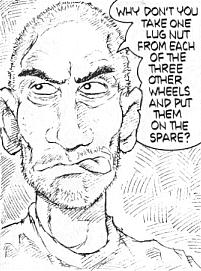Legend: Asylum inmate saves the day for a motorist stranded with a flat tire.
Example: [Asimov, 1992]
Mr. Anderson's automobile suddenly developed a flat tire one night, immediately outside the strong iron fence that walled off the local mental institution. Annoyed but resigned, Anderson jacked up the car and prepared to replace the wheel. He took off the hubcap, unscrewed the bolts, which he placed in the hubcap, which in turn was resting in the road, and placed the spare tire with its hub onto the axle. He was about to reach for the hubcap with its bolts when a speeding car raced by and, even as There was no possibility of finding the bolts in the dark, and, helplessly, Anderson realized he was standing there with a wheel on the axle, unbolted and useless. While he wondered what to do, a man from the other side of the fence shouted, "Hey, mister." Anderson looked up, surprised, and realized that he had attracted the attention of one of the mental inmates, who had been watching the procedures by the light of the street lamps. Anderson said cautiously, "Yes? Is there something you want?" "I just want to give you some advice. Look — just take off the other hubcaps and remove one bolt from each wheel and use them for that spare tire you have. The other wheels will be held by four bolts apiece and your spare by three. That will hold you till you get to the nearest repair shop, where you can get additional bolts and an additional hubcap." "Great," said Anderson. "You're perfectly right. Now why didn't I think of that?" Then, embarrassed, he said, "It's really amazing that, under the circumstances — uh — you could —" "Because I'm in here?" said the inmate contemptuously. "That just means I'm crazy. It doesn't mean I'm stupid." |
Variations:
- Sometimes the hapless car repairer loses the tire nuts through his own carelessness: not paying attention to what he's doing, he spills the fasteners in the ditch.
- Both men and women have turned up as the harried driver in this tale, but the helpful mental patient is invariably male.
Origins: The "helpful crazy" story has been part of contemporary lore since the 1950s. The oldest print sighting we have so far collected comes from 1983, but turning to anecdotal resources, we find that one reader recalls being regaled with the tale in Flagstaff, Arizona in 1977,

where it was told of a breakdown outside the state mental hospital outside Phoenix. Another heard it in Red Bank, Tennessee, in 1969, when the pastor of a local church told it as a joke. A third heard it in
A standard completion to the legend is the "I might be crazy but I'm not stupid" punchline — that perfect little finishing touch seems to have become a fixed part of how various storytellers have chosen to relate the tale.
Rarely do urban legends carry as clear a moral as this particular one does. Even as they laugh over the mental patient's priceless closing line, those who hear the story are receiving a little reminder not to presume additional handicaps when dealing with the disadvantaged. In other words, don't raise your voice to the blind, presuming they must be hard of hearing, and don't address yourself to the one behind the wheelchair under the foolish assumption that the one being pushed isn't competent to speak for himself.
Another anecdote uses the same closing:
By coincidence, four bridge players once were committed simultaneously to the neuropsychiatric ward of a
[Olsen, 1960]
Barbara "handi crap" Mikkelson
Sightings: Look for this legend in the 1983 Jeremy Leven novel, Satan: His Psychotherapy and Cure by the Unfortunate
Last updated: 31 December 2004
 Sources:
Sources:
 Also told in:
Also told in:The Big Book of Urban Legends. New York: Paradox Press, 1994. ISBN 1-56389-165-4 (p. 14).
